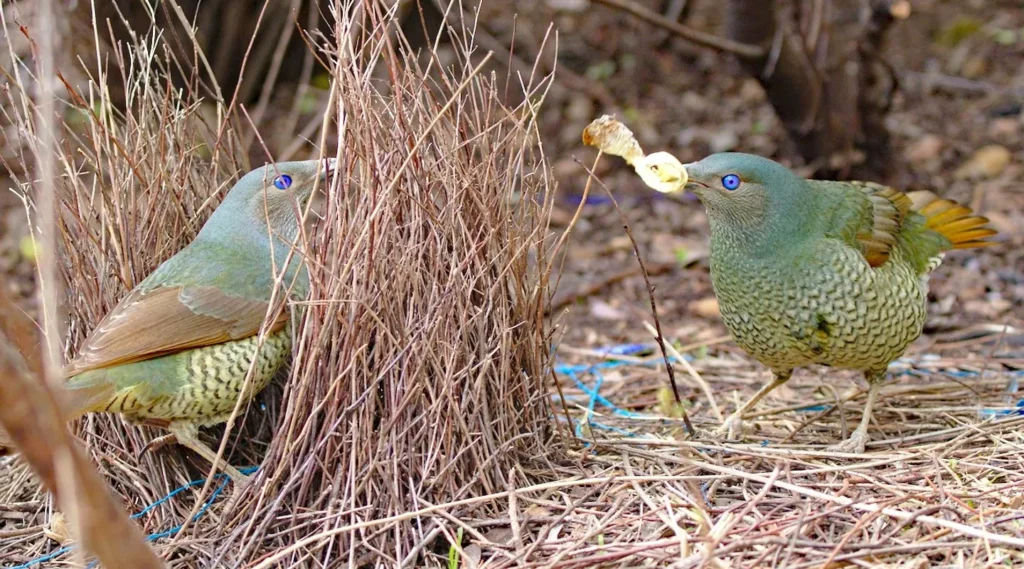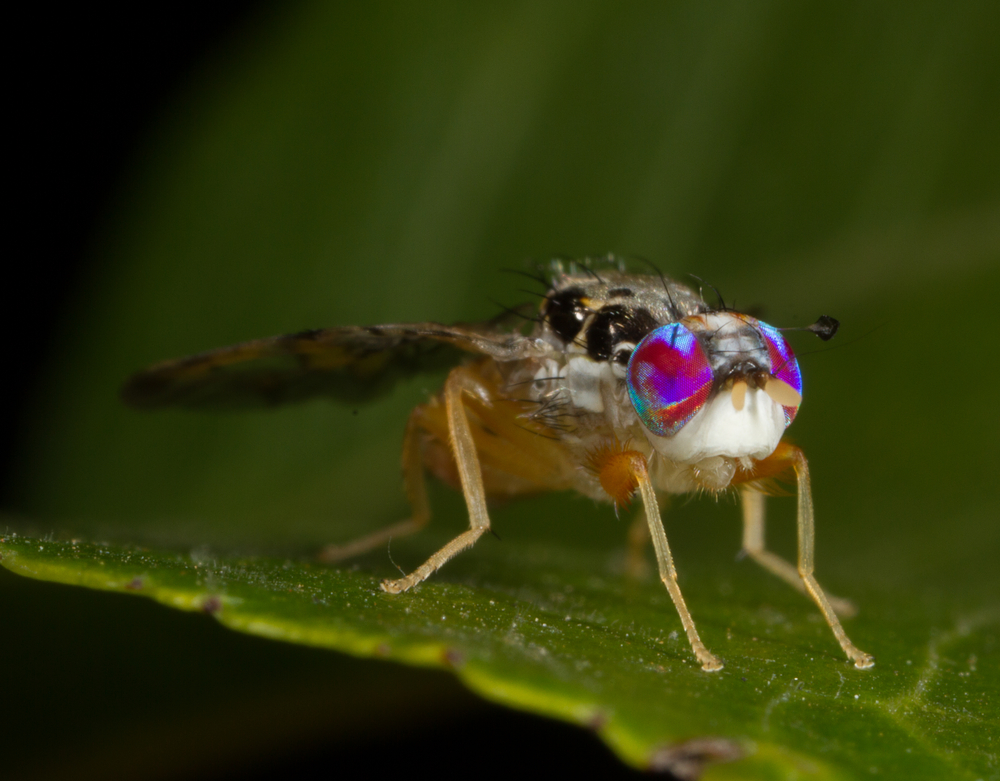Are you ready to dive into a world where animals rock the most fashionable eye color? Get ready to be mesmerized by these incredible creatures with one common trait – their stunning purple eyes! From a bird that’s an artistic genius to a fish that’s tiny but mighty, we’ve rounded up the top five animals with eyes that will make you say, “Purple is the new black!” So, prepare to be amazed and get ready to feast your eyes on these captivating pictures of nature’s most vibrant and stylish eye shades. Let’s meet the stars of our show – the Satin Bowerbird, the Violet Dancer, the Pink-Eyed Goby, the Mediterranean Fruit Fly, and the Blue Viper. Get ready to be purple-ized!
Satin Bowerbird: The Artistic Bird with Purple Eyes

satin bowerbird
Coming from the lush rainforests of eastern Australia is a fascinating creature that captivates with its artistic flair and enchanting purple eyes—the Satin Bowerbird. This bird, scientifically known as Ptilonorhynchus violaceus, is truly a visual spectacle. Males, adorned in jet-black plumage, and females, sporting mainly brown feathers, both share these mesmerizing purple eyes, setting them apart from their avian peers.
| Scientific Name | Type of Animal | Location |
|---|---|---|
| Ptilonorhynchus violaceus | Bird | Eastern Australia |
The Satin Bowerbird is not just about beauty—it is also about art and love. The males showcase their artistic skills during the complex yet captivating courtship process. They construct elaborate structures, known as bowers, that serve as stages for their mating rituals. These bowers are meticulously decorated with a variety of shiny and colorful items, from naturally occurring objects like flowers to man-made materials such as vibrant pieces of plastic.
Read more: What Eats Hawks? Discover the Main Hawk Predators and Uncover the Unexpected Predator
Springtime in the southern hemisphere, from October to February, marks the nesting season for these birds. During this time, the rainforests of Eastern Australia come alive with the vibrant spectacle of Satin Bowerbirds’ mating rituals.
With a diet primarily consisting of fruits, these birds also occasionally feast on leaves and insects. This dietary preference contributes to their overall health and vitality, ensuring they remain the captivating creatures that they are.
Through their unique mating rituals, vivid purple eyes, and artistic tendencies, the Satin Bowerbirds offer a remarkable glimpse into how diverse and colorful the animal kingdom can be. Truly, they are among the many wonders of our natural world.
Violet Dancer: The Damselfly with Mesmerizing Purple Eyes
Let us whisk you away from the artistic realm of Satin Bowerbirds and guide you to a world that’s equally enchanting, yet markedly different. Venture with us to the verdant landscapes of North America where the Violet Dancer, a captivating subspecies of the variable dancer, thrives.
This petite damselfly, barely reaching 1.2 inches or 3 cm in length, is a prevalent sight along the water bodies during the summer months. The Violet Dancer, with its purple thorax and abdomen adorned with black stripes, is indeed a sight to behold. But what truly sets it apart are its remarkable purple eyes— a visual treat that echoes the enchanting beauty of nature itself.
Read about: What Eats Frogs? Unveiling the Hidden World of 16 Frog Predators
The rivers, streams, and ponds come alive with a flurry of these damselflies, their purple forms darting through the air, reflecting the sunlight off their vibrant bodies. Their presence adds a surreal hue to the landscape, an iridescent spectacle that’s hard to miss.
While their artistic counterparts, the Satin Bowerbirds, captivate with their unique rituals and diet, these damselflies mesmerize with their sheer beauty and vibrancy. They are a testament to the rich biodiversity that our planet harbors, each species with its unique characteristics, and each equally fascinating.
Easy to distinguish from their counterparts, Violet Dancers are a delightful anomaly in the world of damselflies. Their striking purple eyes, an unusual feature in the animal kingdom, make them a fascinating subject for those interested in the wonders of nature.
As we leave the world of Violet Dancers, we continue our journey to explore the next creature with enchanting purple eyes. But the memory of their vibrant colors and the gentle dance of these damselflies lingers on, a reminder of the stunning diversity that nature has to offer.
Pink-Eyed Goby: The Tiny Fish with Purple Eyes
Imagine the crystalline waters of the Indo-Pacific Ocean, a paradise for marine life, hiding a gem of its own – the Pink-Eyed Goby. This tiny fish, no more than an inch long, is a captivating wonder with eyes that sparkle in a mesmerizing shade of purple.
Unlike the grandeur of the Satin Bowerbird or the surreal beauty of the Violet Dancer damselfly, the Pink-Eyed Goby’s charm lies in its simplicity. It’s a creature that’s easy to overlook in the vibrant underwater world it calls home. Nevertheless, it’s a testament to nature’s surprises, proving that sometimes, the smallest creatures can be the ones that capture our hearts the most.
The Pink-Eyed Goby is a tropical species, preferring the warm waters of the Red Sea, the Indian Ocean, and the Pacific Ocean. It’s a creature of the reefs, living amongst the Acropora hard corals. It’s not unusual to see them hovering around these corals, their purple eyes gleaming like tiny lanterns in the underwater gloom. When danger lurks, they dart quickly into the labyrinth of branches that the corals provide, a fascinating spectacle for any diver lucky enough to witness it.
These gobies live in large groups, a sight to behold as they move in unison, their bodies almost transparent save for the striking purple hue of their eyes. They are a testament to the wonders of the underwater world, a world that is just as vibrant and diverse as the one above it.
As we move on to discover more creatures with purple eyes, let’s not forget the small and unassuming Pink-Eyed Goby. It might not be as noticeable as some of the larger creatures we’re used to, but it’s definitely a sight worth seeing if you ever find yourself exploring the coral reefs of the Indo-Pacific Ocean.
Mediterranean Fruit Fly: The Pests with Mesmerizing Purple Eyes

maditerranean fruit fly
The world of pests is not often associated with beauty. However, there is one tiny creature that defies this stereotype with its captivating eyes – the Mediterranean fruit fly, or scientifically known as Ceratitis capitata. These small insects, whilst nuisances in the agricultural world, are undeniably visually intriguing, primarily due to their vibrant, multi-colored eyes that dazzle in hues of purple, red, blue, and green.
Born in the heart of Africa, the Mediterranean fruit fly has expanded its wings, taking flight across the globe to become a worldwide presence. But it’s not a welcome sight for everyone. The United States Department of Agriculture (USDA) has ironically crowned this beauty as the most significant agricultural pest.
Check out: Are These the Most Stunning Orange Animals? See the Pictures and Decide for Yourself!
These flies have a penchant for a wide variety of fruits, nuts, and vegetables. It’s not the adult fly that devours these foods, but their offspring. Adult flies lay eggs within these food sources, creating a feast for their larvae upon hatching. Despite their destructive nature, it’s impossible to ignore the aesthetic appeal of these pests, particularly their vibrant eyes that seem to hold an entire galaxy within.
Although the Mediterranean fruit fly is a pest, it’s a stunning example of nature’s paradoxical beauty. While the males of this species adorn a sleek black coat, the females flaunt a mainly brown color. But the real showstopper is, undoubtedly, their most striking feature – their purple eyes.
Their diet primarily consists of fruits, but they do not shy away from occasional leaves and insects. Their ability to thrive in tropical and subtropical climates has facilitated their global spread, making them a fascinating, yet pesky, part of our ecosystem.
Check out: What Eats Kangaroos? Unveiling the Top 6 Predators and Surprising Herbivorous Non-Predators
These tiny creatures, measuring just about 1 inch, are a testament to the fact that size doesn’t diminish beauty. The Mediterranean fruit flies serve as a reminder that even in the most unexpected places, nature has a way of surprising us with its charm and vibrancy.
Blue Viper: A Mesmerising Glimpse into the Venomous World of Purple-Eyed Reptiles

viper snake
The tropical warmth of Indonesia’s Lesser Sunda Islands serves as a thriving habitat for a stunning creature of the night – the Blue Viper. Its scientific name, Trimeresurus Insularis, might sound intimidating, but it’s the snake’s captivating eyes that steal the spotlight. Just as we’ve seen with the Pink-Eyed Goby and the Mediterranean fruit fly, this viper also flaunts an eye color that is nothing short of intriguing – an enchanting shade of purple.
Unlike the uniform hues found in the eyes of our previous animals, the Blue Viper exhibits a kaleidoscope of colors. Their eyes can be a classic black, a vibrant orange, a refreshing green, and sometimes, an alluring purple. This variability is a testament to the biodiversity and genetic richness that nature proudly showcases.
“Despite the danger they pose, the vibrant eyes of the Blue Viper make them an enthralling spectacle in the wild.”
Though their beauty is undeniable, these snakes are not for the faint-hearted. They are aggressive, venomous, and their active hours align with the setting sun. As dusk descends, the Blue Viper awakens, transforming the evening into a hunting spree. Their victims include everything from rodents and small mammals to frogs, birds, and lizards.
Read more: Are Hawks Friendly? Discover the Surprising Truth and Find Out if You Can Keep Hawks as Pets
Despite their predatory nature, these snakes remain an essential part of their ecosystem, keeping the population of their prey in check. It’s a paradoxical world where beauty can often mask danger, and the Blue Viper is a perfect example.
Indeed, the animal kingdom, with its vibrant diversity, never ceases to amaze. From the artistic Satin Bowerbird to the tiny Pink-Eyed Goby, and now the venomous Blue Viper, we’ve embarked on an exciting journey. Let’s continue to delve deeper into the fascinating world of purple-eyed creatures.
The Satin Bowerbird is an animal with purple eyes that is endemic to the rainforests of eastern Australia.
The violet dancer is a subspecies of the variable dancer, a common damselfly in North America. It has purple thorax and abdomen with black stripes, as well as purple eyes.
The pink-eyed goby is a fish found in the Indo-Pacific Ocean. It is known for its purple eyes.
The blue viper, scientifically known as Trimeresurus Insularis, is a reptile with variable eye colors. These can include black, orange, greenish, or purplish eyes.

